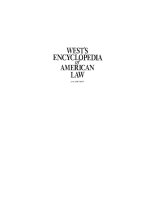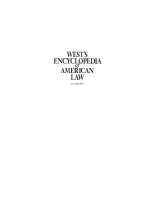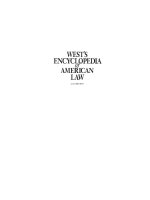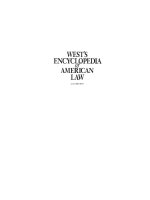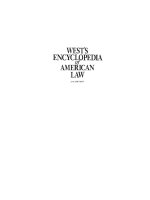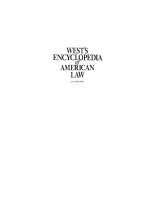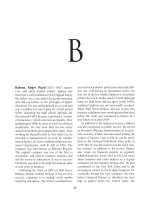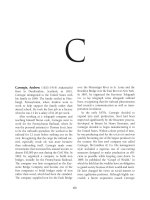encyclopedia of american business (davis folsom)
Bạn đang xem bản rút gọn của tài liệu. Xem và tải ngay bản đầy đủ của tài liệu tại đây (5.66 MB, 863 trang )
Encyclopedia of
american business
Revised Edition
GENERAL EDITOR
W. DAVIS FOLSOM
ASSOCIATE EDITOR
STACIA N. VANDYNE
Encyclopedia of American Business, Revised Edition
Copyright © 2011, 2004 by W. Davis Folsom
All rights reserved. No part of this book may be reproduced or utilized in any form or by any
means, electronic or mechanical, including photocopying, recording, or by any information
storage or retrieval systems, without permission in writing from the publisher.
For information contact:
Facts On File, Inc.
An imprint of Infobase Learning
132 West 31st Street
New York NY 10001
Library of Congress Cataloging-in-Publication Data
Encyclopedia of American business / general editor, W. Davis Folsom ; associate editor, Stacia N.
VanDyne.—Rev. ed.
p. cm.
Includes bibliographical references and index.
ISBN 978-0-8160-8112-7 (hc : alk. paper)
ISBN 978-1-4381-3592-2 (e-book) 1. United States—Commerce—Encyclopedias. 2. Business—
United States—Encyclopedias. 3. Finance—United States—Encyclopedias. 4. Industries—United
States—Encyclopedias. I. Folsom, W. Davis. II. VanDyne, Stacia N.
HF3021.E53 2011
338.097303—dc22 2010028372
Facts On File books are available at special discounts when purchased in bulk quantities for
businesses, associations, institutions, or sales promotions. Please call our Special Sales Depart-
ment in New York at (212) 967-8800 or (800) 322-8755.
You can find Facts On File on the World Wide Web at
Excerpts included herewith have been reprinted by permission of the copyright holders; the
author has made every effort to contact copyright holders. The publisher will be glad to rectify,
in future editions, any errors or omissions brought to its notice.
Text design by Erika K. Arroyo
Illustrations by Patricia Meschino
Composition by Hermitage Publishing Services
Cover printed by Yurchak Printing, Inc., Landisville, Pa.
Book printed and bound by Yurchak Printing, Inc., Landisville, Pa.
Date printed: June 2011
Printed in the United States of America
10 9 8 7 6 5 4 3 2 1
This book is printed on acid-free paper.
P
LIST OF ENTRIES iv
INTRODUCTION xiii
INTRODUCTION TO THE SECOND EDITION xiv
LIST OF CONTRIBUTORS xv
ENTRIES A–Z 1
BIBLIOGRAPHY 818
INDEX 822
CONTENTS
P
P
List of EntriEs
Accounting Oversight Board
accounts payable, trade credit
accounts receivable
accrual basis, cash basis
achievement motivation
activity-based costing
adaptability screening
adjusting entry, trial balance,
adjusted trial balance
administrative law
adoption process
advertising
affluent society
affluenza
agency theory
agricultural support programs
Aid to Families with Dependent
Children
American Bankers Association
American Bar Association
American Customer Satisfaction
Index
American depository receipts
American dream
American Federation of Labor
and Congress of Industrial
Organizations (AFL-CIO)
American Industrial Revolution
American Institute of Certified
Public Accountants
American Medical Association
American Society for Quality
American Stock Exchange
Americans with Disabilities Act
amortization
amortized loan
annual report
annuity
antitrust law
arbitrage
arbitration
assembly line
assembly plants
assessment center
assets
attention, interest, desire, action
concept
attitudes, interests, opinions
statements
auditing
automatic stabilizers
Auto Pact
bad debts, aging of accounts
bait-and-switch
balance of payments
balance sheet
Baldrige Award
banking system
Bank of International
Settlements
Bank of the United States
barriers to entry
barter
beggar-thy-neighbor policy
benchmarking
beta coefficient, capital asset
pricing model
Better Business Bureau
Big Mac Index
bill of lading
Black Monday, Tuesday, Thursday
blind trust
blue-chip stocks
blue-collar
blue laws
board of directors
bonds
book value
Border Environmental
Cooperation Commission
boycotts
Bracero program
Brady bonds
brain drain
brands, brand names
break-even analysis
Bretton Woods
bribery
Buddhist economics
budget, personal
budgeting, capital budgeting
Bureau of Economic Analysis
Bureau of Labor Statistics
Bureau of Land Management
business and the U.S.
Constitution
business cycles
business ethics
business failure
business forecasting
business language
business logistics
business plan
Business Roundtable
business taxes
business valuation
Buy American Act and
campaigns
iv
List of Entries v
buy-grid model
buying-center concept
bylaws
cafeteria plans
callable bond
capital
capital expenditure, revenue
expenditure
capital gain, capital loss
capitalism
capital markets, money markets
carbon tax
carry trade
cartel
cash-flow analysis
cash management
cause marketing
caveat emptor
cease and desist
Center for Science the Public
Interest
centrally planned economy
Certified Public Accountant
ceteris paribus
chain-of-command principle
Chamber of Commerce
Chicago Board of Trade
Chicago Mercantile Exchange
chief executive officer
chief financial officer
Children’s Online Privacy
Protection Act
churning
circuit breakers
circular flow model
Civil Aeronautics Board
Civilian Conservation Corps
civil procedure
Civil Rights Acts
class-action lawsuits
classical economics
Clayton Antitrust Act
Clean Air Acts
Clean Water Act
closed-end fund
closely held corporation
Coalition for Environmentally
Responsible Economies
Coase theorem
code of ethics
collection agencies
collective bargaining
collusion
Commerce Business Daily
commerce clause
commercial law
commercial paper
Committee on Foreign
Investment in the United
States
Commodity Credit Corporation
Commodity Futures Trading
Commission
commodity markets
common law
common stock, preferred stock,
treasury stock
comparable worth
comparative advantage
compensation and benefits
competition
competitive advantage
compounding, future value
Comptroller of the Currency
computer-aided design,
engineering, and
manufacturing
Conference Board
conflict of interest
conglomerate
consent decree
consignment
conspicuous consumption
consumer advocacy
consumer bankruptcy
consumer behavior
consumer buying process
consumer credit counseling
service
Consumer Credit Protection
Act
consumer economics
Consumer Price Index
Consumer Product Safety
Commission
consumer protection
Consumers Union
consumption
consumption tax
contestable market theory
contingency fee
contingency theory
contract
contract theory
cookies
cooperative
copy
copyright, fair use
corporate average fuel efficiency
corporate culture
corporate divestiture
corporate governance
corporate haven
corporate personhood
corporate security
corporate social responsibility
corporate welfare
corporation
cost-benefit analysis
cost of goods sold
cost-of-living adjustment
cost-push inflation
costs
counterfeit goods
countertrade
countervailing duties
countervailing power
country-risk analysis
Court of International Trade
creative capitalism
credit cards
Credit Card Accountability
Responsibility and Disclosure
Act of 2009
credit counseling services
credit default swaps
credit practices rule
credit-reporting services
vi List of Entries
credit scoring
credit union
critical path method
cross-cultural communication
cross-price elasticity of demand
crowding-out effect
cultural industries
CUSIP
customer loyalty
customer-relationship
management
customer relations/satisfaction
customs union
cyberspace
cycle time
damages
database management
Davis-Bacon Act
day trading
debenture
debit, credit
debtor-in-possession financing
deceptive trade practices
decision tree
decoupling
default
deflation
deleveraging
Delphi technique
demand
Deming’s 14 points
demographics
Department of Commerce, U.S.
Department of Labor, U.S.
Department of the Interior, U.S.
Department of Transportation,
U.S.
Department of the Treasury,
U.S.
dependency ratios
deposit expansion multiplier
depreciation, depletion,
amortization
deregulation
derivative securities
direct investment
direct mail
direct marketing
disclosure duties
discounting, present value
discount rate
dispute settlement
distribution channels
diversification
dividends, retained earnings
division of labor
document-retention policy
do not call registry
dot-coms
Dow Jones averages
downsizing
due diligence
due process
dumping
Dun & Bradstreet reports
duration
earnings management
e-business
e-commerce
economic conditions
economic development
economic efficiency
Economic Espionage Act
economic freedom
economic growth
economic institutions
economic policy
economic rent
economic systems
economies of scale, economies
of scope
efficient market theory
e-government
80/20 principle
elasticity of demand
electronic data interchange
Electronic Fund Transfer Act
electronic funds transfer
embargo
embezzlement
emerging markets
eminent domain
employee assistance program
employee benefits
employee motivation
employee recruiting
Employee Retirement Income
Security Act
employee stock-ownership plan
employment
employment-at-will
empowerment
empowerment zones, enterprise
zones
Endangered Species Act
entrepreneurship
environmental impact statement
Environmental Protection
Agency
environmental scanning
Equal Credit Opportunity Act
equal employment opportunity
and affirmative action
Equal Employment Opportunity
Commission
Equal Pay Act
equation of exchange
equilibrium
equity
equity income theory
ergonomics
escalator clause
ethnocentrism
European Union
exchange-rate risk
exchange rates
exchange traded funds
exit strategies
expectancy theory
experience and learning curves
export controls
Export-Import Bank of the
United States
exporting
externalities
extraterritorial jurisdiction
factoring
factory tours
List of Entries vii
FAFSA
F
air and Accurate Credit
Transactions Act
Fair Credit Reporting Act
Fair Debt Collections Practices
Act
fair disclosure
fair housing laws
Fair Labor Standards Act
Fair Packaging and Labeling Act
Family and Medical Leave Act
family farm
family-friendly business
practices
family life cycle
Farm Credit System
fast track
featherbedding
Federal Aviation Administration
federal budget
Federal Communications
Commission
federal courts
Federal Deposit Insurance
Corporation
Federal Financial Institutions
Examinations Council
federal funds market
Federal Home Loan Bank
System
Federal Home Loan Mortgage
Corporation
Federal Housing Administration
Federal Mediation and
Conciliation Service
Federal National Mortgage
Association
Federal Reserve System
Federal Trade Commission
fiduciary duties
financial accounting
Financial Accounting Standards
Board
financial instrument
financial intermediaries
financial markets
Financial Planning Association
financial ratios
financial statements
first in, first out; last in, first out
first-mover advantage
fiscal policy
fiscal year
five Cs of credit
flowchart
flow of funds
focus groups
Food and Drug Administration
forced-ranking systems
Foreign Corrupt Practices Act
foreign exchange
foreign investment
Foreign Sovereign Immunities
Act
foreign trade zones
401(k) plan
franchising
fraud
Freedom of Information Act
free on board
free trade
free-trade areas
futures, futures contracts
future value
game theory
gap analysis
garnishment
gender gap index
General Accounting Office
generally accepted accounting
principles
General Services
Administration
Giffen goods
Gini ratio
glass ceiling
globalization
global brand
global shares
goal setting
gold standard
goodwill, going concern
government debt
government, economic roles of
government ethics
Government National Mortgage
Association
government-sponsored
enterprises
Gramm-Leach-Bliley Act
graphs
gray markets
Great Depression
green cards
green marketing
Gresham’s law
gross domestic product
Gross National Happiness
growth stocks
guaranteed investment contract
harmonization
Harmonized Tariff System
Hawthorne experiments
health maintenance
organization
hedge fund
hedging
Herfindahl Index
hierarchy of effects
Hofstede’s dimensions
holding company
home equity line of credit
human resources
identity theft
import restraints
imports/exports
income
income elasticity of demand
income redistribution
income statement, gross margin
incorporation
independent contractors
Index of Consumer
Expectations
indicators
individual retirement account
industrial-organizational
psychology
viii List of Entries
Industrial Workers of the World
inflation
infomercials
infrastructure
initial public offering
injunctions
input-output
insider trading
Institute for Supply
Management
Institute of Management
Accountants
institutional advertising
insurance
intellectual property
Inter-American Development
Bank
interest
interest rates
interlocking directorate
Internal Revenue Service
International Brotherhood of
Teamsters
International Energy Agency
International Labor
Organization
international management
international marketing
International Monetary Fund
International Trade
Commission
Internet
Internet Fraud Complaint
Center
Internet marketing
Internet surveys
internships
Interstate Commerce
Commission
interviewing
inventory control
investment
investment banking
investment clubs
investment fraud
ISO standards
job satisfaction
joint venture
Jones Act
jumbo mortgage
just cause
just-in-time production
Keogh plan
Keynesian economics
know-how
knowledge management
Kondratev waves
Kyoto Protocol
Labor/employee relations
labor force
labor markets
laissez-faire
Landrum-Griffin Act
layoff
leadership
leasing
lemon laws
letter of credit
leverage
leveraged buyout
liability
licensing
lien
life cycle
Lily Ledbetter Act
limited liability company
limited liability partnership
loans
local option sales tax
Lorenz curve
loss leader
macroeconomics
Madison Avenue
magistrate’s court
Magnuson-Moss Warranty Act
mail surveys
make-or-buy decisions
Malthusian trap
management
management gurus
managerial accounting
manufacturers’ representatives
maquiladoras
marginal analysis
market concentration
market failure
marketing communications
marketing concept
marketing-information systems
marketing strategy
market intelligence
market research
market segmentation
market-share, market-growth
matrix
market structure
market value
mark-to-market accounting
Marshall Plan
Maslow’s hierarchy of needs
mass customization
mass merchandising
master of business
administration
matrix management
mercantilism
mergers and acquisitions
metropolitan statistical area
microeconomics
micro lending
middle managers
minimum wage
mission statement
mixed economy
Model Business Corporation
Act
modern portfolio theory
monetary policy
money
money supply
monopolistic competition
monopoly
Montreal Protocol
Moody’s ratings
moral hazard
moral suasion
mortgage
most-favored-nation clause
List of Entries ix
mo
tivation theory
multilevel marketing
multinational corporation
multiple listing service
mutual funds
mutual interdependence
Nader’s raiders
National Association of
Securities Dealers Automated
Quotation System
National Bureau of Economic
Research
national income accounting
National Industrial Recovery
Act
National Labor Relations Board
National Mediation Board
negligence
negotiable instruments
nepotism
new-product development
New York Clearing House
Association
New York Mercantile Exchange
New York Stock Exchange
nominal versus real
nontariff barriers
normal goods/inferior goods
Norris-LaGuardia Act
North American Agreement on
Labor Cooperation
North American Development
Bank
North American Free Trade
Agreement
North American Industry
Classification System
observation
Occupational Safety and Health
Administration
Office of Federal Contract
Compliance Programs
Office of Government Ethics
Office of Management and
Budget
oligopoly
ombudsmen
open-market operations
open skies
opinion leader
opportunity cost
options, option contracts
organizational commitment
organizational learning
organizational theory
organization behavior
Organization for Economic
Cooperation and
Development
Organization of American
States
Organization of Petroleum
Exporting Countries
outplacement
outsourcing
Overseas Private Investment
Corporation
owner’s equity
packaging
parallel markets
parity
partnership
patent
P
ATRIOT Act, USA
payroll taxes
penny stock
Pension Benefit Guaranty
Corporation
perfect competition
performance appraisal
personal finance
personal-interview surveys
personal property
personal selling
peso crisis
Peter principle
Phillips curve
poison-pill strategies
political action committee
pollution rights
Ponzi scheme
positioning
poverty line
predatory lending
price ceilings, price controls
price discrimination
price fixing
price floors, price supports
price indexes
pricing strategies
primary markets, secondary
markets
privacy
privatization
problem solving
process theories
Producer Price Index
producers
product
production
production-possibilities curve
product liability
product life cycle
product-market growth matrix
product placement
product proliferation
profit
profit maximization
profit sharing, gain sharing
program evaluation and review
technique
program trading
project management
promissory note
property rights
property taxes
proprietary information
proprietorship
prospectus
proxy
public administration
public choice theory
public debt and deficit
public relations
public service announcements
public utilities
puffery
purchasing
x List of Entries
purchasing power parity theory
push and pull strategies
pyramid of corporate
responsibility
quality control
questionnaires
queuing theory
quitclaim and warranty deed
Racketeer Influenced and
Corrupt Organization Act
random-walk theory
real estate appraisal
real estate investment trusts
Real Estate Settlement
Procedures Act
real income
recession
reciprocity
reductions in force
reference group
relationship marketing
repurchase agreements, reverse
repurchase agreements
request for proposal, invitation
to bid
research and development
reserve requirements
residual value
Resolution Trust Corporation
Resource Conservation and
Recovery Act
resources
restraints of trade
restrictive covenants
retailing
retirement plan
return on investment
right-to-know laws
right-to-work laws
risk management
risk, uncertainty
Robinson-Patman Act
rule of 72
rules of origin
safety and health
sales force compensation
sales forecasting
sales management
sales promotion
sanctions
Sarbanes-Oxley Act of 2002
saving
savings and loan associations
S corporation
Section 301, Special 301, Super
301
Securities and Exchange
Commission
Securities Industry Association
securitization
seniority
services
sexual harassment
shareholders
Sherman Antitrust Act
short sale
short selling
shut-down point
simplified employee pension
sinking fund
Small Business Administration
Smoot-Hawley Tariff Act
social audit
social facilitation
socialism
social loafing
socially responsible investing
social mapping
social media
Social Security
Society for Competitive
Intelligence Professionals
stakeholders
Standard & Poor’s
standard of living
Standard Rate and Data Service
stock market, bond market
stock options
stock-rating systems
strategic alliances
strategic planning
strengths, weaknesses,
opportunities and threats
(SWOT) analysis
stress tests
Student Loan Marketing
Association
subprime lending
Superfund
Supplemental Security Income
supply
supply rule
supply-side economics
sustainable growth and
development
sweatshop
synergy
systemic risk
t-account
Taft-Hartley Act
takings clause
target markets
tariff
taxes
tax incremental funding
tax shelter
technical analysis
technology transfer
telemarketing
telephone surveys
tender offer
Tennessee Valley Authority
theory of constraints
Theory X and Theory Y
think tanks
360-degree feedback
time deposits
time management
tobacco settlement
total-quality management
trade adjustment assistance
trade balance
trade barriers
trademark
trade marketing
List of Entries xi
trade
secrets
trade shows
training and development
transaction costs
transfer payments
transfer taxes
transformational readership
transparency (market)
trickle-down economics
Troubled Assets Relief Program
trust
Truth in Lending Act
two-factor theory of motivation
tying contracts
underground economy
undertime
Underwriters Laboratory
underwriting
unemployment
Uniform Commercial Code
union
United Farm Workers
United States-Canada Free
Trade Agreement
U.S. Agency for International
Development
U.S. Census Bureau
U.S. Commercial Service
U.S. Customs Clearance
U.S. Customs Service
U.S. Trade Representative
U.S. Treasury securities
usury
Value-Added Tax
Veblen goods
venture capital
vertical integration
viral marketing
visas
vision statement
volatility (market)
wage and price controls
Wagner Act
Wall Street
warranty
wealth
welfare
Wheeler-Lea Act
wheel of retailing
whisper numbers
whistle-blower
white-collar
wholesaler
women in business
work council
Worker Adjustment and
Retraining Notification Act
workers’ compensation
Works Progress Administration
World Bank
World Intellectual Property
Organization
World Trade Organization
World Wide Web
wrongful discharge
yield curve
zero-base budgeting
zero-sum game
zoning
List of EntriEs
P
xiii
The Encyclopedia of American Business is designed
to assist students and other individuals in under-
standing the complex world of American business.
The United States’s economy, at more than $14 tril-
lion in 2010, is the largest economy in the world.
The many organizations, institutions, government
agencies, laws, and business concepts that make
up the U.S. economic system create a complex and
confusing, yet exciting, business environment. The
goal in creating this encyclopedia is to provide
readers with a resource to help them understand
the many facets of American business. With the
focus on American business, this encyclopedia
provides useful insight for businesspeople around
the world learning about the U.S. system.
Two major resources were used in determin-
ing which topics to include in the encyclopedia.
The first was the Wall Street Journal, the quintes-
sential U.S. business newspaper. Issues, concepts,
laws, and institutions discussed in the Journal
were a major source of topics for this book. The
second was “principles” texts used in beginning
management, marketing, economics, finance, and
accounting courses. Principles texts introduce stu-
dents to concepts, laws, and institutions that make
up the world of business. The goal is to provide
short summaries of these topics as a resource for
students and individuals learning about American
business.
I would like to thank many individuals who
assisted with this project, including Dr. Tao Jin;
Dr. Kendra Albright; Dr. Robert Williams; Profes-
sor Megan Fox; Melissa Hudson; Judy Mims; Vera
Basilone; Tom Odom; our Facts On File editor,
Owen Lancer; and the many contributing authors
who assisted this effort. Thanks also to the Univer-
sity of South Carolina Beaufort for the support and
resources used in creating this work.
This book is dedicated to the many “teach-
ers,” family, and friends who have influenced and
enriched my life, including Myrtle and Morris Fol-
som; Ralph, Ellen, Roger, and Herb Folsom; Kathy
and Brad Folsom; Dr. A. Robert Koch, Dr. Alpha
Chang, Bertie Nelson “The Pro” Butts, Kathie
Turick Robie, Jerry and Faye Rosenthal, Phil and
Marilyn Ray, Bert and Lucille Keller, Helen Reece,
Dr. Robert Botsch, Dr. Jim Snyder, and Dr. Mack
Tennyson.
A special thanks to Stacia VanDyne for her
careful and insightful editing.
introduction
xiv
P
So much has changed since the publication of the
first edition. Corporate giants including General
Motors, Federal National Mortgage Association,
and Merrill Lynch retreated from the center stage
of American business. American financial mar-
kets, once a dominant force in the world, panicked
and froze. A recession, deeper than any since the
1930s, threw our business system into a myriad of
crises.
Understanding our economic system became
a concern for all Americans. The second edi-
tion includes added emphasis on financial mar-
kets, instruments, and regulatory authorities. New
entries, including subprime mortgages, multiple
listing services, consumer economics, and invest-
ment fraud, are all designed to add to consumers’
understanding of their role and rights in the busi-
ness of America.
introduction to thE
sEco
nd Edition
xv
P
List of contributors
R A, MLIS, University of South
Carolina
R A, University of South
Carolina Beaufort
D B, Librarian CME Coordinator,
Lowell General Hospital
J B, University of South Carolina
P B, MLS, Simmons College
A B, University of South
Carolina
B B, MLIS, University of South Carolina
D. C S B, Professor, University
of South Carolina Aiken
D. R B, Professor, University of
South Carolina Aiken
B M. B, MLS, Simmons College
J H B, MLIS, University of
Maine, Farmington
J B, University of South Carolina
Beaufort
L W. C, Reference Librarian, Clark
County Library
W C, MLIS, University of South
Carolina
K M. C, University of South Carolina
Beaufort
T C, MLIS, University of South
Carolina
D. E L. C, American
University
R L. C, MLIS, University of South
Carolina
J C, MLS, Simmons College
J D, University of South
Carolina Beaufort
M D, University of South Carolina
M C. D, MLIS, University of
South Carolina
M E D, MLIS, University of
South Carolina
K B E, MLIS, University of
South Carolina
M D. F, MLS, Simmons College
R F, MD, SC Ethics
Commission
R F, JD, Professor, University of San
Diego Law School
L K F-G, University of
South Carolina Beaufort
L V G, Librarian, Simmons
College
K G, MLS, Simmons College
A G, MLIS, University of South
Carolina
J G, University of South Carolina
Beaufort
S G, Reference Librarian, Nixon
Peabody LLP
K S. G, MLIS, University of South
Carolina
G G, University of San Diego Law
School
C L. H, MLIS, University of South
Carolina
R. J H, University of South Carolina
Beaufort
M H, University of South Carolina
Beaufort
L I, University of South Carolina
Beaufort
K J, University of South Carolina
Beaufort
xvi List of Contributors
L T J, MLIS, University of
South Carolina
K K, MLIS, Louisiana State University
A S. J, Librarian, Simmons College
A K J, MLS, Simmons College
J P J, MLIS, University of South
Carolina
A K, MLIS, University of South
Carolina
J A. K, MLS, Simmons College
J F. K, Librarian, University of South
Carolina
J K, MLIS, Louisiana State
University
J R. L, MLIS, University of South
Carolina
J L, MPA, Valdosta State University
J A. LM, MLIS, University of South
Carolina
M L, MLIS, University of South Carolina
G L, MLIS, Louisiana State
University
C D. L, University of South Carolina
T L, MLIS, University of South Carolina
G LC, MLIS, University of South
Carolina
R L, A.G. Edwards and Sons
M L, University of South Carolina
Beaufort
L M W, MLIS, University of South
Carolina
T M, MLS, Simmons College
P M, MLS, Simmons College
A M, University of South
Carolina
K L. M, MSW, MLS, Newton,
Massachusetts
T L MD, MLS, Simmons College
J MG, MLS, Simmons College
D. L MG, Professor, University of
South Carolina Aiken
D. L B MK, Professor, College of
Charleston
C MK, MLS, Simmons College
D. J M, Assistant Professor, Valdosta
State University
J M, University of South Carolina
Beaufort
A M, MLIS, University of South
Carolina
K M, MLIS, University of South
Carolina
J M, MLIS, University of South Carolina
J M, Instructor, University of South
Carolina Beaufort
B M, MLIS, Louisiana State University
M M, MLIS, University of South
Carolina
S S-M, MLS, Simmons College
M M, MLS, Simmons College
B M, MLIS, University of South Carolina
J N, University of South Carolina Beaufort
L H O’Q, MLIS, University of
South Carolina
L O, University of South Carolina
Beaufort
M P, MLIS, University of South Carolina
A R, MLIS, University of South
Carolina
K V. R, MLS, Simmons College
J R, Zip’s Business Services
J R, University of Chicago
D J. R, MLS, Simmons College
K R, MLIS, University of South
Carolina
D. H R, Professor, College of
Charleston
R P, MLIS, University of South
Carolina
S P, MLIS, Medical College of
Georgia
J S, Sawyer Partnership
A S, University of South Carolina
Beaufort
L M. S, Reference Librarian, Simmons
College
S S, MLIS, University of South
Carolina
S J. S, MLS, Simmons College
T S, MLIS, University of South Carolina
J S, MLIS, University of South
Carolina
List of Contributors xvii
D G. S, MLS, Simmons College
A G S, MLIS, Westvaco
Corporation
J R. S, University of South
Carolina Beaufort
D. M T, Professor, College of
Charleston
F U, J., Valdosta State University
A V, MLS, Simmons College
G W, MLS, Simmons College
A W, MLIS, Louisiana State
University
D P. W, University of South Carolina
Beaufort
C W, University of South Carolina
Beaufort
D W, MLIS, Simmons College
S Y, University of South Carolina Beaufort
K A Y, MLIS, Simmons College
D Z, MLS, Simmons College
Special Assistance
Dr. Kendra Albright, University of South Carolina
Professor Megan Fox, Simmons College
Dr. Tao Jin, PhD, Professor, Louisiana State
University
Dr. Robert Williams, Professor, University of
South Carolina
1
P
Accounting See ;
; .
Accounting Oversight Board
The Public Company Accounting Oversight Board
(PCAOB) is a five-member board created when
the Sarbanes-Oxley Act was signed into law on
July 30, 2002. The AOB was established to protect
the interests of the investors and the integrity of
financial markets. It was set up in response to the
scandals at Enron, WorldCom, and Andersen as a
means for Congress to assure investors, employees,
and pensioners that the hardships and losses they
had suffered would not be repeated.
The AOB performs the following duties:
registers public accounting firms; establishes
, , ethics, indepen-
dence, and other standards relating to the prepa-
ration of audit reports for issuers; conducts
inspections of accounting firms; conducts inves-
tigations and disciplinary proceedings, impos-
ing appropriate sanctions; enforces compliance
with the Sarbanes-Oxley Act and other pro-
fessional standards; and sets the budget and
manages the operations of the Board and its
staff. The PCAOB is thus given the power to
discipline accountants and issue subpoenas. It
also has authority to amend, modify, repeal,
and reject any standards suggested by the pro-
fessional groups of accountants and any advi-
sory groups. Some of these relevant groups are:
the FASB (F A S
B), the IASB (International Accounting
Standards Board), the FASAB (Federal Account-
ing Standards Advisory Board), the GASB (Gov-
ernmental Accounting Standards Board), and
the AICPA (A I C-
P A). The AOB must
report its standard-setting activity to the S-
E C annually.
It requires registered public accounting firms
to prepare and maintain files for a period of at
least seven years, to audit work papers and other
information related to an audit report in suf-
ficient detail to support the conclusions reached
in the report.
Members of the board are appointed by the
Securities and Exchange Commission (SEC) in
consultation with the Federal Reserve Chairman
and the Secretary of the Treasury. The Sarbanes-
Oxley Act states that board members must be
“prominent individuals of integrity and repu-
tation who have demonstrated commitment to
the interests of investors and the public, and an
understanding of the responsibilities and nature
of financial disclosure ... and the obligations of
accountants with respect to the preparation and
issuance of audit reports with respect to such
disclosures.” By law, two members of the board
must be or must have been
A
2 accounts payable, trade credit
s and the three remaining members
must not be and cannot have been certified public
accountants. Members of the board are appointed
for a five-year term during which time they will
serve on a full-time basis.
Soon after the Accounting Oversight Board
came into existence, controversy arose over the
process of selecting board members. The SEC
named William Webster, former director of both
the FBI and the CIA, as chairman of the board in
a divided vote (a 3-2 approval). Criticism mounted
after the New York Times reported that Web-
ster had warned SEC Chairman Harvey Pitt, but
not the entire Commission, before the vote on
his nomination that he had recently headed the
auditing committee of a company facing
accusations from investors. Additionally, SEC
Commissioner Harvey J. Goldschmid argued that
Pitt had initially promised the chairmanship to
John Biggs, head of the giant teachers pension fund
TIAA-CREF, who had called for tight oversight
of the accounting industry. Goldschmid further
argued that Pitt had changed his mind under pres-
sure from the industry and Republican lawmakers.
There was general consensus among SEC members
to open an investigation into the process used to
select William Webster and other board mem-
bers. Webster subsequently resigned his position
as chairman.
In 2009 Mark W. Olson, a former member of
the Federal Reserve’s Board of Governors chaired
the PCAOB. Other board members included
Daniel L. Goelzer, former general counsel at the
SEC; Bill Gradison, a former member of Con-
gress; Steven B. Harris; and Charles D. Niemeier,
formerly a senior enforcement official at the SEC.
All of the PCAOB board members, except the
chair, have served since the creation of the board
in 2002.
The Accounting Oversight Board is funded by
assessed contributions from publicly traded -
s. The Board collects a registration fee
and an annual fee from every public accounting
firm in amounts that are sufficient to recover the
of processing and reviewing applications
and s.
Further reading
American Institute of Certified Public Accountants.
“Summary of Sarbanes-Oxley Act of 2002.” Ameri-
can Institute of Certified Public Accountants Web
site. Available online. URL: />
sa
rbanes_oxley_summary.htm. Accessed on May 27,
2003. “Statement by SEC Commissioner: New Pub-
lic Company Accounting Oversight Board by Com-
missioner Harvey J. Goldschmid,” U.S. Securities and
Exchange Commission, Open Committee Meeting,
October 25, 2002. Accessed on May 27, 2003. URL:
www.sec.gov/news/press.html.
—Beth Myers
accounts payable, trade credit
Accounts payable are a part of a firm’s current
liabilities, debts that must be paid within the short
term. The accounts payable are the firm’s trade
credit. As the firm does business with its suppliers
and other firms on a credit basis, accounts pay-
able accrue. Trade credit is a source of
for the firm. Using invoices instead of cash, trade
credit facilities purchases from suppliers and oth-
ers; cumbersome cash transactions aren’t neces-
sary when firms have good trade credit. When the
accounts payable are kept current (i.e., paid on a
timely basis), trade credit creates a good reputa-
tion for the firm among those with whom it does
business.
To encourage the early payment of invoices,
most suppliers’ invoices contain sales discounts.
There are percentages that can be deducted for the
early payment of an invoice. A commonly used
sales discount found on invoices is “2/10, net 30.”
This means that 2 percent may be deducted from
the invoice if payment is made within 10 days of
the invoice date; otherwise the full amount of the
invoice is due within 30 days of the invoice date.
Sales discounts apply to short periods of time,
usually 10 or 15 days, but when expressed as an
annual percentage rate, these discounts are con-
siderable and are powerful incentives for credit
customers to pay early. The sales discount of
“2/10, net 30” is greater than 36 percent when
expressed as an annual percentage rate; “1/15, net
30” is approximately a 24-percent annual percent-
accrual basis, cash basis 3
ag
e rate. Consider a firm with a sizable amount of
trade credit, which consistently pays its bills late,
not taking advantage of the sales discounts. Such
a firm is using its suppliers’ money, borrowing it at
more commonly associated with
s and finance companies.
accounts receivable
Accounts receivable are part of a firm’s ;
they represent monies owed to the firm. (While
receivables are assets, payables are liabilities to a
firm. Payables are the firm’s debt—that is, monies
owed by the firm.) An account receivable is created
when a firm sells a good or service to a customer
on credit (see , ). Rather than receiv-
ing an asset in the form of cash, the firm records
an asset called an account receivable. The sum of
all the monies owed to the firm by its customers
collectively is called accounts receivable.
Because accounts receivable are assets, debit
entries will increase accounts receivable, and credit
entries will decrease accounts receivable. Because
of the dual nature of a transaction (an exchange of
equal-valued resources between two parties), for
every account receivable in a firm’s ledger, there is
an equal-valued account payable in another firm’s
ledger.
Every firm that sells on credit will have an
in accounts receivable. The presence
of accounts receivable, especially when sizable,
creates a cash-flow problem for a firm. A sale was
made; the merchandise was sold, but it was not
liquidated (cash was not received). Thus, accounts
receivable are in reality a pool of idle cash. To
offset cash-flow problems, the accounts receiv-
able need to be collected on a timely basis. Firms
monitor their investment in accounts receivable by
comparing their “days sales outstanding” (DSO)
ratio with that of their industry.
A popular way firms attempt to offset cash-
flow problems associated with receivables is to
offer sales discounts on the invoices sent to their
credit customers. Sales discounts are percentages
that can be deducted for the early payment of an
invoice. A commonly used sales discount found on
invoices is “2/10, net 30.” This means that 2 percent
may be deducted from the invoice if payment is
made within 10 days of the invoice date; otherwise,
the full amount of the invoice is due within 30 days
of the invoice date. These sales discounts apply to
short periods of time, usually 10 or 15 days, but
when expressed as an annual percentage rate, these
discounts are considerable and are powerful incen-
tives for credit customers to pay early.
Because it is impossible to predict with accu-
racy which customers are good credit risks, it is
natural and expected that some of the accounts
receivable will ultimately prove to be uncollect-
ible, at which time they will be written off as
. Bad-debt expense can be minimized by a
tightening of a firm’s credit policy. However, there
is a trade-off: having a tight credit policy means
that a firm will sacrifice sales to its marginal credit
customers. Periodically a firm may review the
status of its accounts receivable using an account-
ing method known as aging of accounts receivable
(see , ), where the
outstanding balance of each account and its -
are determined.
See also , .
accrual basis, cash basis
(GAAP) require accounting on the accrual basis,
as opposed to the cash basis for accounting. In
cash-basis accounting, revenues are recorded when
the monies are received. Expenses are recognized
and recorded only when they are paid. In other
words, revenues and expenses are recorded only
when there is a movement of cash either into or
out of the firm, respectively. The use of cash-basis
accounting is found in only a few types of busi-
nesses, namely restaurants, medical offices, and
legal firms.
Accrual-basis accounting is based upon GAAP,
primarily the revenue and matching principles.
The revenue principle requires that revenues be
recognized and recorded when they are earned;
this may not be at the same time that the revenues
are received. For example, suppose a firm sells a
computer on credit in December 2009, and the
customer pays for the purchase in January 2010.
4 achievement motivation
Using the accrual basis, the sale and revenue is
recorded when the transaction occurs—that is,
in 2009. When payment from the customer is
received in the next year, this is an entirely sepa-
rate transaction and is recorded with the other
transactions of the firm for the year 2010. (If cash-
basis accounting were used, the firm would not
record the computer sale in 2009, although that is
when the sale was made. It would record the com-
puter sale in 2010, because that is when the firm
received payment for the computer. Transactions
in cash-basis accounting are not recorded unless
there is either a receipt or payment of money.)
It is impossible for a firm to generate revenue
without incurring some sort of expense. When a
good is sold, the expense account—
—is debited (increased). If a service is per-
formed, labor and/or supplies expense is debited.
The matching principle requires that the expenses
incurred in the generation of a firm’s revenue for
a particular time period be recorded (included)
in the same time period as the revenues to which
they are related. For example, suppose a firm
receives its telephone bill in January for its tele-
phone expense that month, and the firm pays that
bill two months later, in March. Even though the
expense is paid in March, it is a January expense,
not a March expense. The matching principle
requires the expense to be recorded in January.
It is evident from the examples above that an
accurate measurement of a firm’s periodic rev-
enues and expenses in only realized with accrual-
basis accounting. In the accrual basis, revenues
and expenses are recorded when the sale is made
and the expense is incurred. Cash-basis account-
ing ignores the concept of periodicity by recording
revenues and expenses only when money changes
hands. For this reason, accrual-basis accounting is
generally accepted.
achievement motivation
Achievement motivation has to do with how
inspired people are to pursue and accomplish
their goals. When an individual does accomplish
a desired goal, it typically results in a sense of
positive self-worth, which contributes to personal
and professional growth and development. The
motivation to achieve may be affected both by
dispositional characteristics, such as individuals’
perceptions of their abilities and potential to suc-
ceed; and by external forces, such as the promise
of rewards for success or threat of punishment for
failure.
Some individuals appear to have an intrinsi-
cally high level of achievement motivation. These
people typically do not require the use of external
incentives to prompt them to work towards their
goals because they already have the desire to do so.
People who are motivated mainly by a high need to
achieve will seek out challenging tasks and work
hard to succeed at them. People low in the need
for achievement tend to pursue very easy tasks,
where the chances of success are high; or they
choose tasks that are extremely difficult, where no
reasonable person could be expected to succeed.
Thus when failure occurs, it is not attributed to the
person’s lack of skills or abilities but to the difficult
nature of the task.
In contrast, some individuals are driven pri-
marily by a fear of failure rather than a need to
achieve. This fear of failure may lead them to
avoid challenging tasks altogether. People who are
motivated mainly by this fear will avoid the risks
presented by difficult or complex tasks, precisely
because they may result in failure. Instead, these
individuals tend to prefer easy tasks where, even
though the rewards may be small, the chances of
success are great. A smaller subset of individu-
als may be motivated by a fear of success. People
who fear success may worry that after succeeding
at a challenging task, other people will raise their
expectations of them. The pressure of these expec-
tations, coupled with the individual’s fear that he
or she will be unable to continue success at that
level, may lead these individuals to sabotage their
own efforts to succeed in the first place. Thus they
avoid the potential anxiety and pressure associated
with success.
In addition, the nature of any given task may
affect an individual’s decision to pursue it and how
hard that person tries to succeed. Specific tasks
may elicit either intrinsic or extrinsic motivation,
activity-based costing 5
or
both. Intrinsic motivation involves the desire
to perform a behavior or task for its own sake,
perhaps because the person finds it pleasurable or
exciting. Extrinsic motivation involves performing
a behavior or task in order to earn external rewards
or to avoid punishments. Maximizing intrinsic
motivation appears to be very effective for increas-
ing and maintaining the performance of a desired
behavior. Therefore employers or supervisors who
try to make routine tasks more interesting or excit-
ing may increase the chances that employees will
want to work on those tasks.
On the other hand, providing external motiva-
tors for a task that is already intrinsically motivat-
ing may backfire, inadvertently decreasing the
person’s intrinsic motivation to perform it. For
example, one study found that people who were
given money as an external motivator for working
on a puzzle found the puzzle to be less interesting
than people who were not paid for working on it.
Extrinsic rewards may change people’s perceptions
of how attractive or fun a particular task may be.
In other words, once someone receives money for a
task, it becomes more like work than like pleasure.
In this respect the extrinsic reward may be inter-
preted as a control device used to entice a person
into working on a task that has little intrinsic
value.
However, the use of extrinsic rewards can be
highly effective under certain conditions, such as
when they are used to provide feedback or infor-
mation concerning a person’s performance. For
example, when a salesperson receives an unex-
pected bonus for successful work, he may increase
his future efforts, thus leading to improved perfor-
mance rather than a decreased interest in continu-
ing the task.
Finally, achievement motivation is linked to
in the sense that people
motivated by a high need to achieve will likely
seek out challenging tasks at work and strive to
accomplish them. Employees with a high level of
achievement motivation can contribute in signifi-
cant ways to the success of any business.
See also ;
.
Further reading
Baron, Robert A., and Donn Byrne. Social Psychology.
11th ed. Boston: Allyn and Bacon, 2006; Myers, David
G. Exploring Psychology. 7th ed. New York: Worth Pub-
lishers, 2007.
—Elizabeth L. Cralley
acquisitions See .
activity-based costing
Activity-based costing (ABC) is a cost-accounting
tool that attempts to determine the cost of each
activity in the production or service process. Tra-
ditional cost accounting focuses on accumulating
the total cost of the item produced by cost inputs
(i.e., salaries, materials, overhead). ABC overcomes
the deficiencies in this process by looking at the
cost from an activity perspective instead of an
inputs perspective. For example, a traditional cost-
accounting system may say the painting department
had the following for painting one appliance:
direct labor, $20; direct materials, $10; assigned
overhead, $20. An activity-based cost system would
show the cost by activities: sanding, $5; cleaning, $5;
spraying, $25; drying, $10; inspection, $5.
At the heart of this concept is the handling of
overhead. Traditional cost accounting incorrectly
assigns overhead based on some other cost such as
direct labor. This often causes erroneous manage-
ment data that assigns too much overhead to large
jobs and too little to small jobs. It may allocate too
much overhead to departments with less machin-
ery and too little overhead to departments with
more machinery.
Activity-based accounting tries to address this
shortfall by allocating cost based on what it calls
“cost drivers.” Cost drivers are the items in the busi-
ness that create overhead. Examples of cost drivers
include number of production runs, number of
engineering change orders, number of purchase
orders, number of vendors, and number of parts.
Activity-based costing requires the additional effort
needed to determine what cost drivers are produc-
ing the overhead, and then it allocates the overhead
to the activities based on the driver. This gives a
much more accurate total cost calculation.
6 adaptability screening
adaptability screening
Adaptability screening is identifying prospective
employees who will be most likely to adjust to a
company’s work environment. Psychologist Dr.
Saul Sells, who developed adaptability screening
in the 1950s, emphasized the need to study behav-
ior in its natural setting. In his first adaptability
screening research, Dr. Sells tested pilots training
for the U.S. Air Force and then assessed their per-
formance in combat during the Korean War. His
research became the basis for pilot selection and
performance prediction.
Adaptability screening is now used in a wide
variety of businesses. Predictive models help
managers estimate the needed staffing level,
adjusting for sick leave, relief, and physical con-
ditions. Models can also predict which workers
will adjust to shift work, changing schedules in
factories operating 24 hours a day. By identifying
those workers who can adjust to changes in sleep,
fatigue, and health, adaptability screening can
reduce absenteeism and improve safety and the
work environment.
When combined with payroll systems and
task load management, the results of adaptability
screening can be used to optimize production
operations. Screening also reduces training costs
through more effective recruitment and retention
rates.
See also -
.
Further reading
Kaplan, D., and R. L. Venezky. What Can Employers
Assume about the Literacy Skills of GED Students? Tech-
nical Publication of the National Center on Adult Lit-
eracy, September 1993; Simpson, D. Dwayne. “Founder
and Former Director of IBR: Saul B. Sells,” American
Psychologist (December 1988): 1088.
adjusting entry, trial balance, adjusted
trial balance
An adjusting entry is a journal entry made at
the end of an accounting period to record accru-
als that have occurred during that time period.
Adjusting entries are common to
accounting, but they are not found in cash basis
accounting. An accrual is an (other than
cash), , equity account, revenue or
expense that has accrued within a particular
accounting period. In the case of a long-term note
receivable, interest income will be earned each
accounting period, although the interest income
may not be received until the maturation of the
note. Interest income will accrue over the life of
the note, and it must be recorded as it is earned,
not when it is received. In the case of a note pay-
able, interest expense will accrue over time. As
interest expense accrues, it must be recorded.
The recognition and recording of such accruals is
normally done at the end of the accounting period
with adjusting entries.
As with most accounting entries, an adjust-
ing entry is a double entry with one account
being debited and another account credited. One
of the entries will always be an -
account (either a revenue account or expense
account), and the other entry will be a
account (either an asset, liability, or equity
account). Because adjusting entries are neces-
sary for the proper application of accrual-basis
accounting, cash is never one of the accounts in an
adjusting entry.
Frequently a trial balance is performed before
the adjusting entries are made. The trial balance,
consisting of a debit and a credit column, is a list-
ing of all the ledger accounts with their net debit
or net credit balances. The total of all the ledger
accounts with debit balances should be equal to
the total of all the accounts with credit balances. If
the total debits are unequal to the total credits, an
accounting error has been made. If there is equal-
ity, the trial balance signals the “green light” to
proceed to the next step in the accounting cycle,
the adjusting entries.
A trial balance constructed after the adjust-
ing entries have been made is called an adjusted
trial balance. As such, the adjusted trial balance
includes all of the firm’s revenue and expense
transactions for that accounting period—that is,
the cash transactions and the accruals. If the total
debits are equal to the total credits, the adjusting

